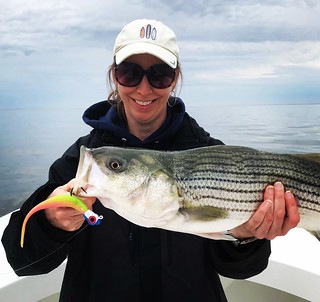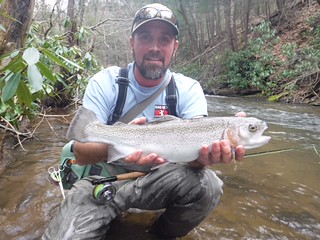Maryland Fishing Report: May 9
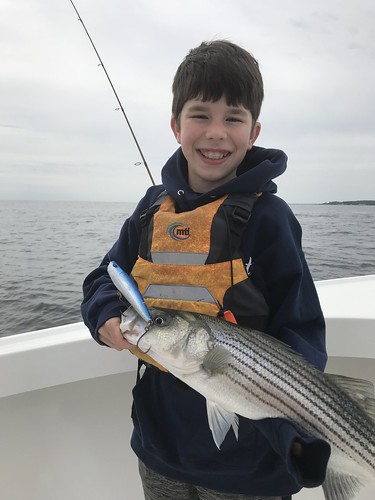
Nick Long had some topwater catch and release fun while fishing with his mom and dad on the Chesapeake Bay this past weekend. Photo by Travis Long
Those who fish know that the waters they love have many moods, and perhaps one of our favorites is when they are quiet and calm.
This past weekend with overcast skies and little wind was one of those times that the waters we fish seem to talk to us – from the bubbling mountain streams, to the calmer waters of ponds, lakes and Chesapeake Bay.
Weekly Fishing Conditions Forecast Summary: May 9-14
The continued blast of warm weather is quickly driving up bay water temperatures, as if we have moved from early spring directly to summer. As the bay comes alive, there are many fishing opportunities for excited anglers.
The Maryland portion of the bay continues to have suitable oxygen conditions from surface to bottom. In addition, there are slightly warmer surface water temperatures so anglers may want to scan these shallower areas for fish during moving water and low light conditions after sunset and before sunrise. Main bay water temperatures are in the mid to upper 60s as reported from the buoys at Annapolis and Gooses Reef. However, expect the continued sunny, warm weather next week to cause water temperatures to approach 70 degrees. In addition, expect temperatures in smaller, dark-bottomed shallow creeks to hold much warmer temperatures. As tides empty the water in these warm creeks, look for nearby structure to target feeding gamefish.
Expect average flows for the Susquehanna, Potomac and smaller rivers and streams entering the bay. There will be above average tidal currents Friday through Tuesday as a result of the new moon May 15.
For the full weekly fishing conditions summary and more detailed and up-to-date fishing conditions in your area of the bay, be sure to check out Click Before You Cast.
Also check out the new Bay Bottom Habitat Mapper that shows bottom type, fishing reefs, popular fishing areas, recent oyster planting sites and submerged aquatic vegetation. The depth/navigation charts backdrop allows you to see their relationship with nearby channel edges, points, humps, flats or other key contour features.
Upper Chesapeake Bay
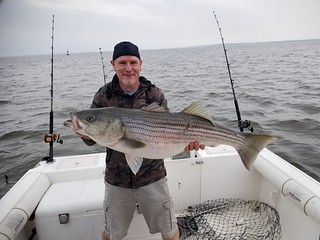
Jeff Dail holds up a nice striped bass he caught while trolling at the Triple Buoys. Photo courtesy Jeff Dail
At the very top of the bay there has been good fishing for white perch in the lower Susquehanna River. Water temperatures are holding around 65 degrees in the river and 67 in Deer Creek. Hickory shad are being caught and released in Octararo Creek and American Shad up near the Conowingo Dam. There has been some hickory shad action at Deer Creek, but most anglers are waiting for a spawning run, which could happen any day.
Department biologist Chuck Stence, who collects hickory shad brood stock from the Deer Creek/lower Susquehanna area for restoration work in other watersheds, filed this recent report: “We finished electro-fishing in the lower Susquehanna last week, Hickory shad were hard to come by this year. The water was extremely cold. White perch and herring just showed up last week. With all of the rain we had two weeks ago, Deer Creek was muddy. We had to fish out in the middle of the river. We muddled through, but it wasn’t easy.”
The Conowingo Dam seems to be on a midday power generation schedule lately with very low flows at night. The striped bass in the area are starting to spawn, and this is good news for trolling in the upper bay below the Brewerton Channel.
Department biologist Beth Versak was kind enough to send us a report from the field as she monitors the upper bay spawning action: “We were in a shallow water site off Aberdeen and the water was 65 degrees. They have definitely begun spawning, but not all. We caught three big females, two pre-spawn and one post. Males are a mix of pre and post-spawn. Finally!”
Those trolling in the upper bay have been picking up a few large striped bass recently near traditional steep edges of the shipping channel. The outside edge near Love Point, the Triple Buoys, Podickory Point and the Dumping Grounds just north of the Bay Bridge are all popular spots to give trolling a try. As more striped bass spawn, more large post-spawn striped bass will be moving down the steeper shipping channel edges. Most angers are trolling large parachutes and bucktails in tandem and some are using umbrella rigs. All this trolling is done off planer boards or flat lines that are allowed to be far astern.
Middle Bay
Surface water temperatures hit 60 degrees this week and are warmer in the tidal rivers and shallower areas. There is still a bit of spawning going on in the major rivers, but most of it is over, which means post-spawn striped bass are moving into the bay and headed south along channel edges.
The steep edges where the current moves along at a good clip create a sort of interstate freeway for these large fish heading south and exiting the bay for their travels north to New England waters. These large girls are looking for big entrees on the Chesapeake Bay menu after more than a month in the upper reaches of the tidal rivers. Large parachutes and bucktails dressed with filleting size sassy shads will be the ticket to this party. Water clarity has been good, so white has been a popular color, but one can never go wrong with chartreuse in a trolling spread. These large girls are often close to the surface in the early morning hours, it pays to be trolling at the crack of dawn, since engine noise will send them down to deeper depths and has been known to cause lockjaw at times. The first licks at post-spawn striped bass leaving the Choptank River will be the False Channel and CP Buoy areas and then the steep channel edge south past R76.
The light tackle jigging for striped bass continues to get better as warmer bay water temperatures prevail. The Bay Bridge piers and rock piles are holding some nice striped bass for some catch-and-release fun until May 16, after which fish under 35 inches can be kept (please be mindful of the new striped bass regulations). Striped bass can also be found suspended along some of the channel edges in the upper bay and the shallow water fishery should begin to develop as fish move about the shallower areas.
The hickory shad run is still going strong in the upper Choptank this week and fisheries biologist that were doing some electrofishing survey work and mentioned there were no fishermen in sight. Great effort was undertaken early this year by fisheries and county personnel to open up the river above Greensboro for small boat traffic so it makes it an ideal location for those fishing from kayaks and canoes.
Lower Bay
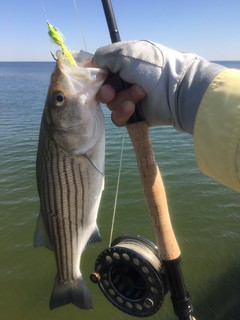
Eric Packard had a little fun fly fishing at Point Lookout and caught and released this striped bass. Photo courtesy of Eric Packard
There is plenty of action in the lower bay region this week since most striped bass heading south will have to pass through this region. The Hooper Island Straits, the main channel down the center of Tangier Sound and the east side of the shipping channel from the HS Buoy south to R72 and beyond are common routes for post-spawn striped bass exiting the Nanticoke River.
On the western side of the bay it is pretty hard to beat the Cove Point channel edge as well as Cedar Point to catch Patuxent River fish and any other large fish coming down the western side of the shipping channel. In the lower Potomac the steep channel edges off St. Clements Island, Piney Point and St. Georges Island are hard to beat. There are also light tackle options in the lower Potomac in regard to jigging for smaller striped bass, when they’re found suspended along channel edges.
Fishing for blue catfish has been good from the mouth of the Wicomico River at Bushwood all the way up to the Wilson Bridge. The general area from Smallwood State Park to the Wilson Bridge tends to be the most popular area to fish, with good boat ramps at Smallwood and Fort Washington. There still reports of good catch-and-release fishing for hickory shad in the Washington, D.C. area of the Potomac. This fishery is a fly casters dream; all it takes is a sinking line, some small shad darts or colorful flies. There is plenty of casting room and plenty of eager hickory shad and American shad to offer some fun catch and release action.
Freshwater Fishing
The western region of Maryland is slowly warming. The region’s trout streams are still quite chilly, which is good for the fish, and the trout management areas are still receiving stockings. The special management areas that are reserved for fly-fishing or catch-and-release offer the very best fishing experience in uncrowded and beautiful settings. The put-and-take areas continue to be stocked and provide the opportunity to take home some trout.
The reservoirs and ponds offer fun fishing for a variety of fish species. Fishing at Deep Creek Lake has been good for smallmouth bass, northern pike, yellow perch, crappie and walleye. Other reservoirs such as Broadford and Piney offer great fishing for largemouth bass and a broad range of panfish. They are great places to fish from shore as well from small boats. The upper Potomac River is in fine shape this week and fishing for smallmouth bass and walleye has been very good. Tubes and stick worms have been good choices fished close to the bottom.
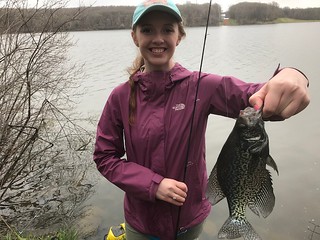
Jessica Klotz got to spend some fun time fishing with her dad recently at Broadford Lake. Photo by Alan Klotz
There are reservoirs and ponds scattered across the Maryland landscape and most offer good fishing for a variety of species. Many are small community ponds that offer some nearby fun fishing where one can find a little peace while casting bait or lures. Others are larger reservoirs that offer exciting fishing from shore or from small boats, kayaks or canoes. The department maintains a list of some of these waters.
Many state parks also offer good fishing opportunities as well.
Largemouth bass are now in their typical spring spawning mode in many of the warmer areas of the southern, eastern and central regions, and remain in pre-spawn mode in the chillier western region. The female bass will soon finish spawning, get off their nests and leave the protection of the eggs and larvae to the male bass. These female largemouth bass will be aggressively looking to build up body stores after the exhaustive spawning process. Shallow areas can be fished with small lipless crankbaits, topwater lures such as frogs and chatterbaits. Transition areas can be effectively worked with spinnerbaits and jerkbaits. Grass is filling in, and targeting the fish with soft plastics is always a winning hand.
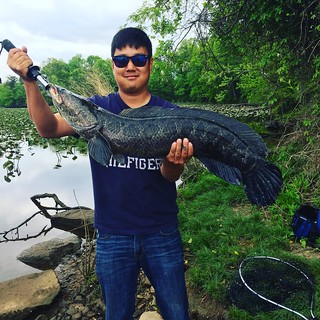
Daniel Kwon holds up a 13 pound northern snakehead he caught in a tributary of the tidal Potomac while casting a topwater frog lure. Photo courtesy of Daniel Kwon
Northern snakeheads will be part of the mix in just about every tidal river and creek in the Chesapeake watershed, and they offer some good eating.
Atlantic Ocean and Coastal Bays
Warmer water temperatures are bringing about some profound changes to the Ocean City area. Ocean water temperatures have risen to about 55 degrees this week and as high as 65 in the back bay waters. Surf casters are fishing with cut bait for a mix of small striped bass, bluefish and black drum and catching a few, although they are being overwhelmed with clear-nosed skates and spiny dogfish.
Around the inlet and Route 50 Bridge area, tautog have moved in and are being caught on sand fleas. Bluefish have also been moving in and out of the inlet. Flounder fishing has been going well inside the inlet and the channels leading to inlet such as the Thorofare channel. Some of the largest flounder are being caught on white Gulp baits. There is also catch-and-release fishing for small striped bass around the Route 50 and Route 90 Bridge areas.
Outside the inlet, boats headed out to the inshore wreck and reef sites are finding good tautog fishing for their patrons. Most are using green crab baits or clams. Some large sea bass are being caught and released giving great hope for the opening of the season. Right now the new federal sea bass regulations are still in the proposed stage, and hopefully there will be some good news shortly.
“The love of angling increases with the lapse of years, for its love grows by what it feeds on.” – James Henshall, 1881
 ABOUT THE AUTHOR Keith Lockwood has been writing the Fishing Report since 2003 and has had a long career as a fisheries research biologist since 1973. Over the course of his career he has studied estuarine fishery populations, ocean species, and over a decade long study of bioaccumulation of chemicals in aquatic species in New Jersey. Upon moving to Oxford on the eastern shore of Maryland; research endeavors focused on a variety of catch-and-release studies as well as other fisheries related research at the Cooperative Oxford Laboratory. Education and outreach to the fishing public has always been an important component to the mission of these studies. Keith is an avid outdoorsman enjoying hunting, fishing, bird dogs, family and life on the eastern shore of Maryland.
ABOUT THE AUTHOR Keith Lockwood has been writing the Fishing Report since 2003 and has had a long career as a fisheries research biologist since 1973. Over the course of his career he has studied estuarine fishery populations, ocean species, and over a decade long study of bioaccumulation of chemicals in aquatic species in New Jersey. Upon moving to Oxford on the eastern shore of Maryland; research endeavors focused on a variety of catch-and-release studies as well as other fisheries related research at the Cooperative Oxford Laboratory. Education and outreach to the fishing public has always been an important component to the mission of these studies. Keith is an avid outdoorsman enjoying hunting, fishing, bird dogs, family and life on the eastern shore of Maryland.

